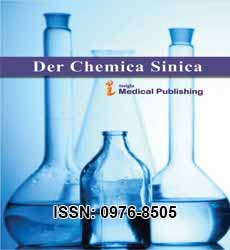ISSN : 0976-8505
Der Chemica Sinica
Photocatalytic Degradation of Dyes Using Metal Oxide Nanocomposites
<P>Syria Rabeay*</P>
<P>Department of Chemistry, University of York, Heslington, UK</P>
<P>*Corresponding author:
Syria Rabeay,
Department of Chemistry, University of York, Heslington, UK,
E-mail: syria@rabeay.uk</P>
<P>Received date: January 01, 2025, Manuscript No. IPDCS-25-20596; Editor assigned date: January 03, 2025, PreQC No. IPDCS-25-20596 (PQ); Reviewed date: January 15, 2025, QC No. IPDCS-25-20596; Revised date: January 22, 2025, Manuscript No. IPDCS-25-20596 (R); Published date: January 28, 2025, DOI: 10.36648/.16.1.3</P>
<P>Citation: Rabeay S (2025) Photo catalytic Degradation of Dyes Using Metal Oxide Nano composites. Der Chemica Sinica Vol.16 No.1:3</P>
Introduction
The increasing release of synthetic dyes into water bodies from industries such as textiles, paper, and plastics has become a major environmental concern due to their toxic, non-biodegradable, and carcinogenic nature. Conventional treatment methods often fail to completely remove these pollutants, necessitating the development of advanced approaches. Photo catalysis using metal oxide Nano composites has emerged as a promising solution, as it exploits the interaction of light with semiconducting materials to degrade complex dye molecules into harmless end products like water and carbon dioxide [1].Description
Metal oxide Nano composites, such as Titanium Dioxide (TiOâ??), Zinc Oxide (ZnO), and Iron Oxide (Feâ??Oâ??), are widely studied for their photo catalytic properties owing to their stability, abundance, and strong oxidative potential. When exposed to light of suitable energy, these semiconductors generate electron-hole pairs that initiate redox reactions, leading to the breakdown of dye molecules. However, limitations such as fast recombination of charge carriers and restricted visible light absorption have spurred the design of Nano composites, where metal oxides are combined with dopants, noble metals, or carbon-based materials to enhance photo catalytic efficiency [2]. The mechanism of photo catalytic degradation involves photon absorption by the nano composite, which excites electrons from the valence band to the conduction band, leaving behind holes. These charge carriers interact with water and oxygen molecules to form highly reactive radicals such as Hydroxyl (â?¢OH) and Superoxide (Oâ??â?¢â??), which attack dye molecules and decompose them into simpler, non-toxic compounds Incorporation of Nano composites improves surface area, charge separation, and light-harvesting ability, thereby accelerating degradation process. The Studies have shown that modified Nano composites extend activity into the visible region, making them suitable for solar-driven water treatment applications [3]. Moreover, their reusability, chemical stability, and potential to operate under sunlight make them highly sustainable compared to traditional methods like adsorption or chemical oxidation. Current research focuses on developing hybrid systems, such as TiOâ??-graphene, ZnO-CuO, and Feâ??Oâ??-based composites, which combine the strengths of different materials for enhanced activity and durability. These advancements highlight the potential of Nano composites in providing cost-effective and eco-friendly solutions for environmental remediation [4]. Furthermore, the incorporation of dopants, surface modifications, and plasmatic nanoparticles has expanded the photo catalytic range of these Nano composites, allowing them to harness visible light more efficiently for pollutant degradation. allowing them to harness visible light more efficiently for pollutant degradation.Recent studies also emphasize the role of nanostructure morphology such as nanotubes, Nano rods, and core shell architectures in optimizing surface area, charge transfer, and reaction kinetics. In parallel, scalable synthesis methods and the integration of Nano composites into functional devices, like membranes and coatings, are being pursued to facilitate real-world applications in water purification, air quality control, and soil decontamination [5].Conclusion
Photo catalytic degradation of dyes using metal oxide Nano composites represents a sustainable and efficient approach to tackling water pollution. By leveraging the synergistic effects of composite materials, these systems exhibit enhanced light absorption, charge separation, and radical generation, ensuring effective breakdown of harmful dyes. With ongoing innovations in material design and an emphasis on solar energy utilization, metal oxide Nano composites hold immense promise for future large-scale applications in wastewater treatment and environmental protection.Acknowledgement
None.Conflict of Interest
None.References
- Meng XX, Du MD, Li YN, Du SJ, Zhao LX, et al. (2024) Solidify Eutectic Electrolytes via the Added MXene as Nucleation Sites for a Solid-State Zinc-Ion Battery with Reconstructed Ion Transport. Nano Lett 24: 8818–8825
Google Scholar Cross Ref Indexed at
- Naguib M, Mochalin VN, Barsoum MW, Gogotsi Y (2014) 25th Anniversary Article: MXenes: A New Family of Two-Dimensional Materials. Adv Mater 26: 992–1005
Google Scholar Cross Ref Indexed at
- Chen XF, Zhu YZ, Zhang M, Sui JY, Peng WC, et al. (2019) N-Butyllithium-Treated Ti3C2Tx MXene with Excellent Pseudocapacitor Performance. ACS Nano 13: 9449–9456
Google Scholar Cross Ref Indexed at
- Forman ME, Jennings MC, Wuest WM, Minbiole KPC (2016) Building a Better Quaternary Ammonium Compound (QAC): Branched Tetracationic Antiseptic Amphiphiles. ChemMedChem 11: 1401–140
Google Scholar Cross Ref Indexed at
- Lainioti GC, Druvari D (2024) Designing Antibacterial-Based Quaternary Ammonium Coatings (Surfaces) or Films for Biomedical Applications: Recent Advances. Int J Mol Sci 25: 12264
Google Scholar Cross Ref Indexed at

Open Access Journals
- Aquaculture & Veterinary Science
- Chemistry & Chemical Sciences
- Clinical Sciences
- Engineering
- General Science
- Genetics & Molecular Biology
- Health Care & Nursing
- Immunology & Microbiology
- Materials Science
- Mathematics & Physics
- Medical Sciences
- Neurology & Psychiatry
- Oncology & Cancer Science
- Pharmaceutical Sciences
